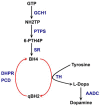Recent advances in the molecular pathogenesis of dystonia-plus syndromes and heredodegenerative dystonias
- PMID: 23814535
- PMCID: PMC3580789
- DOI: 10.2174/157015913804999432
Recent advances in the molecular pathogenesis of dystonia-plus syndromes and heredodegenerative dystonias
Abstract
The majority of studies investigating the molecular pathogenesis and cell biology underlying dystonia have been performed in individuals with primary dystonia. This includes monogenic forms such as DYT1and DYT6 dystonia, and primary focal dystonia which is likely to be multifactorial in origin. In recent years there has been renewed interest in non-primary forms of dystonia including the dystonia-plus syndromes and heredodegenerative disorders. These are caused by a variety of genetic mutations and their study has contributed to our understanding of the neuronal dysfunction that leads to dystonia These findings have reinforced themes identified from study of primary dystonia including abnormal dopaminergic signalling, cellular trafficking and mitochondrial function. In this review we highlight recent advances in the understanding of the dystonia-plus syndromes and heredodegenerative dystonias.
Keywords: Dystonia- plus syndrome; Mitochondria.; Molecular pathogenesis; Neurodegeneration; Secondary dystonia.
Figures

Similar articles
-
The genetics of primary dystonias and related disorders.Brain. 2002 Apr;125(Pt 4):695-721. doi: 10.1093/brain/awf090. Brain. 2002. PMID: 11912106 Review.
-
The genetics of dystonias.Adv Genet. 2012;79:35-85. doi: 10.1016/B978-0-12-394395-8.00002-5. Adv Genet. 2012. PMID: 22989765 Free PMC article. Review.
-
The monogenic primary dystonias.Brain. 2009 Aug;132(Pt 8):2005-25. doi: 10.1093/brain/awp172. Epub 2009 Jul 3. Brain. 2009. PMID: 19578124 Review.
-
Primary dystonia and dystonia-plus syndromes: clinical characteristics, diagnosis, and pathogenesis.Lancet Neurol. 2011 Dec;10(12):1074-85. doi: 10.1016/S1474-4422(11)70232-0. Epub 2011 Oct 24. Lancet Neurol. 2011. PMID: 22030388 Review.
-
Nonprimary dystonias.Handb Clin Neurol. 2011;100:513-38. doi: 10.1016/B978-0-444-52014-2.00038-0. Handb Clin Neurol. 2011. PMID: 21496605 Review.
Cited by
-
Early Onset Ataxia with Comorbid Dystonia: Clinical, Anatomical and Biological Pathway Analysis Expose Shared Pathophysiology.Diagnostics (Basel). 2020 Nov 24;10(12):997. doi: 10.3390/diagnostics10120997. Diagnostics (Basel). 2020. PMID: 33255407 Free PMC article.
-
Oxidative stress and inflammation in the pathogenesis of neurological disorders: Mechanisms and implications.Acta Pharm Sin B. 2025 Jan;15(1):15-34. doi: 10.1016/j.apsb.2024.10.004. Epub 2024 Oct 16. Acta Pharm Sin B. 2025. PMID: 40041912 Free PMC article. Review.
-
A new tyrosine hydroxylase genotype with orofacial dyskinaesia.Sultan Qaboos Univ Med J. 2014 Aug;14(3):e397-400. Epub 2014 Jul 24. Sultan Qaboos Univ Med J. 2014. PMID: 25097778 Free PMC article.
-
Essential tremor-plus: a controversial new concept.Lancet Neurol. 2020 Mar;19(3):266-270. doi: 10.1016/S1474-4422(19)30398-9. Epub 2019 Nov 22. Lancet Neurol. 2020. PMID: 31767343 Free PMC article. Review.
References
-
- Phukan J, Albanese A, Gasser T, Warner T. Primary dystonia and dystonia-plus syndromes: clinical characteristics, diagnosis, and pathogenesis. Lancet Neurol. 2011;10:1074–1085. - PubMed
-
- Trender-Gerhard I, Sweeney MG, Schwingenschuh P, Mir P, Edwards MJ, Gerhard A, Polke JM, Hanna MG, Davis MB, Wood NW, Bhatia K P. Autosomal-dominant GTPCH1-deficient DRD: clinical characteristics and long-term outcome of 34 patients. J. Neurol. Neurosurg. Psychiatry. 2009;80:839–845. - PubMed
-
- Van Hove JL, Steyaert J, Matthijs G, Legius E, Theys P, Wevers R, Romstad A, Moller LB, Hedrich K, Goriounov D, Blau N, Klein C, Casaer P. Expanded motor and psychiatric phenotype in autosomal dominant Segawa syndrome due to GTP cyclohydrolase deficiency. J. Neurol. Neurosurg. Psychiatry. 2006;77:18–23. - PMC - PubMed
-
- Clot F, Grabli D, Cazeneuve C, Roze E, Castelnau P, Chabrol B, Landrieu P, Nguyen K, Ponsot G, Abada M, Diane D, Philippe D, Roger G, Stéphane T, Alana J W, Michael H, Annick T, Fabienne P, Agnès C, Estelle F, Chankannira S, Delphine B, Eric LeGuern, Alexandra D, Marie V, Alexis B. Exhaustive analysis of BH4 and dopamine biosynthesis genes in patients with Dopa-responsive dystonia. Brain. 2009;132:1753–1763. - PubMed
-
- Furukawa Y, Nygaard TG, Gütlich M, Rajput AH, Pifl C, DiStefano L, Chang LJ, Price K, Shimadzu M, Hornykiewicz O, Haycock JW, Kish SJ. Striatal biopterin and tyrosine hydroxylase protein reduction in dopa-responsive dystonia. Neurology. 1999;53:1032–1041. - PubMed
LinkOut - more resources
Full Text Sources
Other Literature Sources
